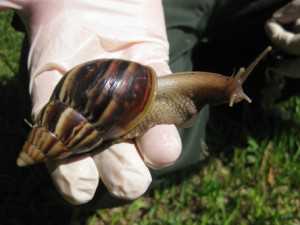Giant Snail Threat Spreading In South Florida

Photo courtesy of FDACS-DPI
According to the Florida Department of Agriculture and Consumer Services (FDACS), giant African land snails (GALS) have been found on a residential property in Davie, FL. The newly discovered site is located in western Broward County, relatively far from where the ravenous, invasive pests have been wreaking havoc for the last three years around several Miami-area neighborhoods.
In addition, a new infestation of an estimated 2,000 snails — some up to five inches in length — has been uncovered in Miami, confirmed FDACS officials.
Florida Commissioner of Agriculture Adam Putnam recently announced that more than 141,000 GALS have been eliminated in Florida since the invasive mollusk was found here in 2011.
“Although we are very concerned about locating giant African land snails outside of the core areas of Miami-Dade County, this find only underscores the importance of the role of South Florida residents to help us successfully eradicate these snails,” said Putnam. “We also appreciate the quick action of the individual who called in the report once he realized the major threat these snails are to agriculture, the environment and human and animal health.”
Originally from East Africa, the GALS, Achatina fulica, is one of the largest land snails in the world, growing up to eight inches in length. Each snail can live as long as nine years. GALS are difficult to eradicate because they have no natural predator and they reproduce exponentially, up to 1,200 more snails per year.
Scientists consider GALS to be one of the most damaging snails in the world because they are known to consume at least 500 different types of plants. The snails cause structural damage to buildings by consuming plaster and stucco to get the calcium they need to grow their shells. The snail also can also carry a parasite, known as rat lungworm, which can cause a form of meningitis in humans.









